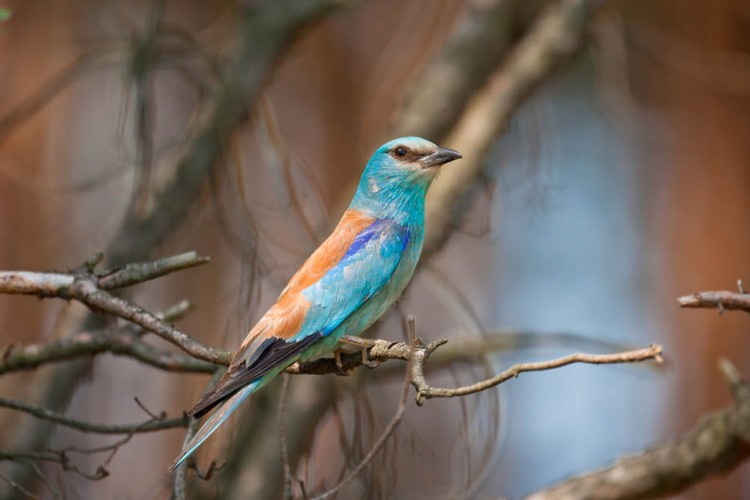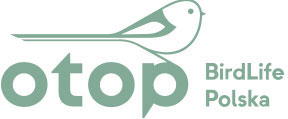
About the project
On October 1, 2011, OTOP launched the project “Active forms of protection of the European Roller in the Kurpiowska Plain”, no. POIS.05.01.00-00-344/10. The project was co-funded by the European Union from the European Regional Development Fund, as part of the scheme Infrastructure and Environment, and subsidised by the National Fund for Environmental Protection and Water Management. The aim of the project was to conserve the population of the Roller in its main area of occurrence in Poland – the Kurpiowska Plain, in the Masovian, the Podlaskie and the Warmian-Masurian Voivodeships. The project ended in September 2015.
The total budget was 2,392,163 zł, of which 2,033,338 zł (85%) were awarded to OTOP by the European Regional Development Fund and 358,825 zł were obtained from the National Fund for Environmental Protection and Water Management.
OTOP has been involved in active protection of the Roller since 2010, when it took up the Warsaw RDOŚ’s initiative on “Active forms of protection of the European Roller (Coracias garrulus) on Kurpiowska Plain within the Mazovia Province”. Since that time, OTOP has held a countrywide monitoring plan of the species, as commissioned by GIOŚ.

The active conservation measures that were implemented in the project, focused on increasing the breeding success of the Roller and on decreasing the mortality of adult and juvenile birds after fledging. They included: putting up nest boxes, protecting broods against predators, preventing degradation and improving the structure of foraging sites, feeding the birds at the time of adverse weather conditions and protecting them against disturbance by people, protecting potential nesting trees and planting new trees. In addition, a comprehensive monitoring plan of the conservation measures was carried out. A promotional campaign on Roller conservation was conducted, both at the national and local scale, including a widely advertised movie, information materials and promotion of knowledge on the species and the project through the media.
The goal of our work was to ensure that the Roller is protected in the future: to this end, we prepared a draft of the National Roller Conservation Plan. The draft Plan was submitted for approval to the General Directorate for Environmental Protection. We hope that after consultation it will be approved and implemented.
We kindly thank the Regional Directorate of State Forests in Olsztyn (Forest Districts: Ostrołęka, Myszyniec) and the Nowogród Forest District for granting permission for project implementation in state forests.
How do we protect the Roller
Protection of breeding sites
Protection of trees with Roller nests was the key conservation action in the project. Trees are damaged by natural events (high wind, fire) and cut by people. The basis for conservation activities is knowledge about the breeding sites, and hence all the occupied sites were identified and monitored. Collaboration with the local inhabitants was initiated, to raise awareness about the importance of hollow trees and consequences of cutting them. A network of volunteers was created, who guarded the most vulnerable Roller sites and reacted and informed us when a site was at risk. As a result, if a tree is destroyed e.g. by wind, compensation measures could be taken, such as putting up nest boxes.
Protection of broods against predators
Painting the trunk of a tree with a Roller’s nest from the ground until about the height of 2 m with turpentine largely protects the nest in a hollow or in a nest box against predators (the stone marten or the pine marten). The smell of turpentine discourages martens from climbing the painted tree. No harmful effects of turpentine for the tree were observed and the method is simple and non-invasive.
Research shows that one nest of the Roller is plundered by martens yearly. With such a small population size it is a big loss. Experience gathered during protection of Greater Spotted Eagles in the Biebrza National Park and annual safeguarding breeding sites of Rollers show that painting a tree with turpentine will often protect it well against martens.
Every year before the arrival of Rollers, trees around 30 sites occupied in the last year are treated. Sometimes groups of trees placed nearby are also painted, because if their canopies touch, martens might move through them.
Putting up nest boxes
Nest boxes were already used in the Kurpiowska Plain in earlier projects carried out by OTOP as commissioned by the RDOŚ in Warsaw and subsidised by the WFOŚiGW in Warsaw. Thanks to this, by 2011, over one third of the Kurpie population in the Masovian Voivodeship (4 pairs in 11 sites with successfully fledged nests) had been using nest boxes. There was a need to continue this measure. Experience from earlier projects had showed that only a large number of nest boxes will ensure nesting success; also, some of the nest boxes used by Rollers were damaged and had to be repaired. Consequently, 300 nest boxes were put up. All the nest boxes were cleaned after the breeding season.
Providing hunting perches
To improve the structure of foraging sites in the breeding territories of Rollers and in other potential habitats, 4 to 5 metre long poles were placed to provide hunting perches and observation sites for Rollers. Suitable foraging places by nest hollows often lack perches, which makes them nearly useless for the birds.
Exposed places where Rollers look out for prey are used as perches for hunting. Tops of dry trees, fences or electricity lines can be used. If there are no such places, despite a good habitat Rollers have limited opportunities to hunt effectively. A relatively simple method is to install artificial perches – providing suitable poles, or, to provide a long-term solution – plant trees, which could be used as perches in the future.
Installing hunting perches could help the birds avoid flying far to find food and bring food to their young more often, which could increase their breeding success. 120 perch sites were constructed (30 in each year) near existing and potential Roller sites.
Planting willows
Ensuring long-term effects of the project was possible not only through direct actions but also through improvement of the habitat for the future. This can be done by, for example, planting willows in farmland, which until recently was a common custom but has today become rare. The planted trees will be used by Rollers as hunting perches and will provide nesting sites in the future. More than a thousand willows were planted using a traditional method – planting willow branches that were earlier put in water. The trees were planted in single spots and in lines along field paths and water courses.
Besides practical aspects, the project also had educational value, since the planting was done by volunteers, including pupils from local schools.
Food supplementation
If cold and rainy weather occurred during the breeding season, selected 15 pairs from the Kurpiowska Plain population were food-supplemented. It was assumed that the duration of adverse weather conditions is on average 10 days per year. Insects (captive-bred crickets) provided in these periods are widely used by bird breeders as a substitute for natural food. Crickets were expected to allow chicks to survive the critical time and thus improve the breeding success of the Rollers.
Food was placed in trays put on feeding station stands. The stands made food exposed, which facilitated finding it by Rollers and reduced the risk of the food being eaten or the trays being overturned by mammals such as dogs, foxes raccoon dogs, wild boars, etc.
The crickets used for food-supplementation have long been bred in Poland as food for captive birds, including Rollers in zoological gardens. We made sure that the crickets were only of the species that is not able to reproduce in the wild in Poland, to avoid the spread of an alien species. Our earlier experience showed that other birds, such as the Red-backed Shrike, occasionally took the supplemented food but it was not observed frequently enough to affect the Rollers.

Supporting extensive pasturage
This action included activities supporting extensive pasturage to save the most valuable pastures, which are feeding sites of the Roller. In farmed land, this was done indirectly by encouraging farmers to enter agri-environmental schemes. In selected plots, in which farming had ceased, pasturage was introduced.
Protection against disturbance by photographers and bird watchers
Many Roller sites, especially those that are easily accessible, located by roads and human settlements, are every year under strong pressure by inexperienced bird watchers and beginner photographers. To counteract this, we organised a network of 15 local care-takers, living in the direct vicinity of the Roller sites that were the most vulnerable to disturbance. Their main tasks included informing people present near a Roller site about threats associated with human disturbance, reporting to the project team about any alarming events that might require additional intervention, and preventing other threats (e.g. those that could cause damage to the breeding site).
To control tourist traffic associated with Roller watching, a hide was built to provide an observation spot that was safe for Rollers. The mobile hide was set up in a carefully chosen place, to enable watching the birds without disturbing them. The hide is surveilled and will be provided with optical equipment for bird watching.
Planning documents
In this action, the National Roller Conservation Plan and Planning Guidelines for Roller Conservation in the Kurpiowska Plain were created.
Promotional and educational activities
A promotional campaign for Roller conservation was launched at the national and local scale, including a widely advertised movie, information materials (a leaflet, an internet webpage, a banner and an information board) and promoting knowledge on the species and on the project through the media.
Photos: R. Dróżdż
Download /only in Polish/
Scenariusz prowadzenia lekcji (PDF)
Links:
About Roller:
Monitoring Kraski w ramach Państwowego Monitoringu Środowiska GIOŚ
Międzynarodowy Plan Ochrony Kraski
Program Aktywnej Ochrony Kraski w Polsce Południowo-wschodniej
Other www:
Centrum Koordynacji Projektów Środowiskowych
Narodowy Fundusz Ochrony Środowiska Program Infrastruktura i Środowisko
RDLP w Olsztynie Nadleśnictwo Nowogród


